HASTELLOY X
HASTELLOY® X
ASTM B435, B366, B572, B619 B622, B626, B751, B775, B829
UNS Number N06002
DIN 2.4665
Other common names: Alloy X, Inconel® HX
 Hastelloy X is a nickel-chromium-iron-molybdenumsuperalloy with outstanding high temperature strength, oxidation resistance, and fabricability. Alloy X’s oxidation resistance is excellent up to 2200° F. This nickel steel alloy has also been found to be exceptionally resistant to stress-corrosion cracking in petrochemical applications. Matrix stiffening provided by the molybdenum content results in high strength in a solid-solution alloy having good fabrication characteristics. Although this nickel alloy is primarily noted for heat and oxidation resistance it also has good resistance to chloride stress-corrosion cracking, carburization, and excellent resistance to reducing or carburizing atmospheres. Two common conditions that often lead to early failure in high temperature alloys, carburization and nitriding, Hastelloy X resists.
Hastelloy X is a nickel-chromium-iron-molybdenumsuperalloy with outstanding high temperature strength, oxidation resistance, and fabricability. Alloy X’s oxidation resistance is excellent up to 2200° F. This nickel steel alloy has also been found to be exceptionally resistant to stress-corrosion cracking in petrochemical applications. Matrix stiffening provided by the molybdenum content results in high strength in a solid-solution alloy having good fabrication characteristics. Although this nickel alloy is primarily noted for heat and oxidation resistance it also has good resistance to chloride stress-corrosion cracking, carburization, and excellent resistance to reducing or carburizing atmospheres. Two common conditions that often lead to early failure in high temperature alloys, carburization and nitriding, Hastelloy X resists.
In what forms is Hastelloy X Available ?
Sheet
Plate
Bar
What are the characteristics of Hastelloy X?
Outstanding oxidation resistance through 2000° F
Resistant to carburization and nitriding
Excellent high temperature strength
Good resistance to chloride stress-corrosion cracking
Chemical Composition, %
| Ni | Mo | Cr | Fe | W | Co | Mn | C |
|---|---|---|---|---|---|---|---|
| Remainder | 8.0-10.0 | 20.5-23.0 | 17.0-20.0 | .2-1.0 | .5-2.5 | 1.0 max | .05-.15 |
| P | S | Si | Al | Ti | B | Cu | |
| .04 max | .03 max | 1.0 max | .50 max | .15 max | .01 max | .50 max |
In what applications is Hastelloy X used?
Gas turbines
Petrochemical industry
Industrial furnaces
Heat treating equipment
Nuclear engineering
Jet engine combustion chambers
Aircraft cabin heaters
Turbine exhaust components
Alloy X is one of the most widely used nickel base superalloys for gas turbine engine combustion zone components such as transition ducts, combustor cans, spray bars and flame holders as well as in afterburners, tailpipes and cabin heaters. It is recommended for use in industrial furnace applications because it has unusual resistance to oxidizing, reducing and neutral atmospheres. Hastelloy X is also used in the chemical process industry for retorts, muffles, catalysts support grids, furnace baffles, tubing for pyrolysis operations and flash drier components.
 Fabrication with Hastelloy X
Fabrication with Hastelloy X
Alloy X has excellent forming and welding characteristics. It can be forged and, because of its good ductility, can be cold worked. It can be welded by both manual and automatic methods including shielded metal arc, gas tungsten arc, gas metal arc and submerged arc processes. The alloy can also be resistance welded. For hot forming, the alloy should be heated to a starting temperature of 2150° F (1175°C).
ASTM Specifications
| Sheet/Plate | Bar |
|---|---|
| B435 | B572 |
Mechanical Properties
Representative Tensile Properties, sheet
| Temp° F | Tensile (psi) | .2% Yield (psi) | Elongation in 2” % |
|---|---|---|---|
| 70 | 110,600 | 54,900 | 44 |
| 1000 | 89,000 | 35,600 | 49 |
| 1200 | 83,000 | 35,400 | 54 |
| 1400 | 67,000 | 34,400 | 53 |
| 1600 | 45,000 | 28,200 | 58 |
- Preview:HASTELLOY C-276
- Next:Hastelloy C-22





